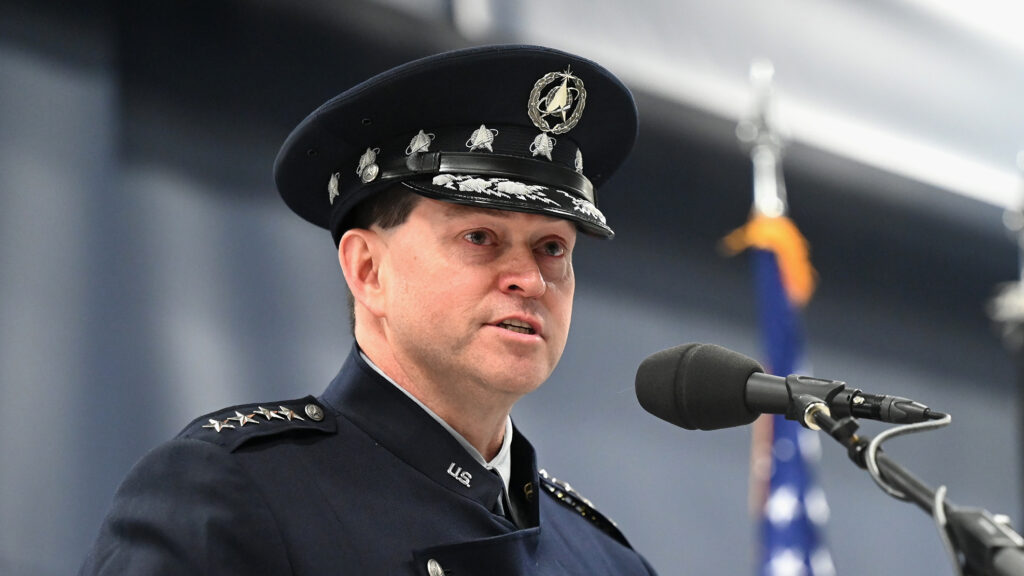THERESA HITCHENS

AIR WARFARE SYMPOSIUM — Chief of Space Operations Gen. Chance Saltzman today laid out a “theory of success” for the Space Force called “competitive endurance” — a three-part conceptual framework for service operations aimed both at deterring conflict in space and fighting “to achieve space superiority.”
The term competitive endurance “is intended to capture the notion that we are in a state of competition with our pacing challenge” — that is, China — and that “remaining” in constant competition is “preferable to the alternative states of crisis or conflict,” he told the annual Air Force Association spring conference. “Endurance” and “managing the stability” in space “will require an active process of campaigning,” he added.
As part of the tri-part plan, Saltzman made clear that establishing space superiority may necessitate “counterspace” operations “to prevent adversaries from leveraging space-enabled targeting to attack our forces.”
In a “Commander’s Note” dated March 3, sent out to Guardians and obtained by Breaking Defense, Saltzman argues that the need for space superiority in the face of adversary threats is a key reason the Space Force was created. “Our Service was established to contest and, when directed, control the space domain on behalf of the Joint Force. … [T]he responsibility to fight for space superiority with military force is why we are a Service and not a functional community” within Space Command, he writes in the note, titled “The Formative Purpose of the Space Force.”
Saltzman told the AFA conference, being held this year in Colorado, that a “theory of success” is a kind of “guiding light” for service operations, and his “competitive endurance” concept is intended to be “a starting point for a dialogue I believe is critical, absolutely critical, to the success of our young service.”
He explained that “the goal of the theory of success is to maximize the Space Force’s contribution to integrated deterrence and deter a crisis or conflict from extending into space.” After all, he said, stealing from Star Trek, preventing conflict in space is the service’s “prime directive.”
But if necessary, his Guardians must ensure that the joint force can achieve space superiority, “while also maintaining the safety, security and long-term sustainability of the space domain,” Saltzman said.
He elaborated that the concept of competitive endurance has “three core tenants,” which revolve around: space domain awareness, using resilience to deter attack, and what might be called ‘responsible’ counterspace activities.
Space Domain Awareness
First, the Space Force “must be able to avoid operational surprise. Avoiding operational surprise in space requires comprehensive and actionable space domain awareness. And by that I mean the ability to make sure we understand what’s happening in space,” he said.
But it also involves being able to “identify behaviors that become irresponsible or even hostile,” he added, “to detect and preempt any shifts in the operational environment that could compromise the ability of the joint force to achieve space superiority.”
Saltzman said that the service already is “investing heavily” in new sensors, “advanced data management” and “decision support tools.” These efforts, he noted are directly tied to the Department of the Air Force’s Advanced Battle Management System (ABMS) development and DoD’s Joint All Domain Command and Control (JADC2) capabilities.
Resilience As Deterrence
“The second tenant for competitive endurance states the US Space Force must deny first-mover advantage in space,” Saltzman said. “The visibility, predictability, and reconstitution timelines associated with current military space architectures, favor the actor that goes on the offensive first. This is an unstable condition that works against deterring attacks on space assets. We can’t have that.”
Therefore, he explained, the service needs to “shift this balance by making an attack on satellites impractical, even self-defeating, discouraging an adversary from taking such actions in the first place.” And one way to do this is by “investing in resilient space order of battle,” which is Air Force Secretary Frank Kendall’s top operational imperative, to essentially be able to quickly replace any lost assets, making it useless to take them out in the first place.
“The Space Force is investing heavily in shifting to more resilient space architectures. Our emerging force designs incorporate attributes like disaggregation, distribution, diversification and protection, maneuverability and proliferation,” Saltzman said.
Balancing Sustainability With Counterspace ‘Campaigning’
“The final tenant for competitive endurance is the Space Force as must prepare to achieve space superiority via responsible counterspace campaigning,” Saltzman said.
He explained that there are “several elements” to this, starting with upholding DoD Secretary Lloyd Austin’s tenets of responsible behavior.
Further, Space Command on March 3 announced that Austin also has signed off on a memo that maps those tenets to military space activities. Those include:Tenet 1: Operate in, from, to, and through space with due regard to others and in a professional manner
Tenet 2: Limit the generation of long-lived debris
Tenet 3: A void the creation o f harmful interference
Tenet 4: Maintain safe separation and safe trajectory
Tenet 5: Communicate and make notifications to enhance the safety and stability ofthe domain
Secondly, Saltzman said, “competitive endurance recognizes the counterspace activities may be necessary to prevent adversaries from leveraging space-enabled targeting to attack our forces — but we will balance our counterspace efforts with our need to maintain stability and sustainability of the orbits.”
He added that the service also is “investing in capabilities that protect our joint force from space-enabled targeting, while understanding that we cannot have a Pyrrhic victory in this domain. In other words, efforts to control the domain cannot inflict such a devastating toll on the domain itself, that our orbits become unusable for following operations.”
No comments:
Post a Comment